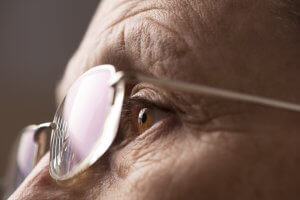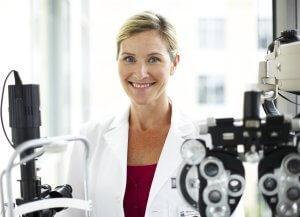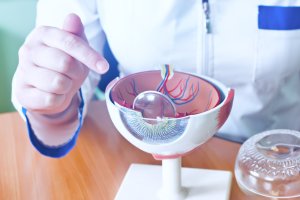What to do about common age-related eye diseases

Voted Best of Berks—
eight years in a row!

There are a number of eye diseases and disorders common in aging adults, although many can really occur at any age.
Cataracts are cloudy areas that cover part of or the entire lens. The eye lens is clear like a camera lens. Cataracts keep light from easily passing through the lens to the back of the eye (the retina), causing the loss of eyesight. Cataracts often form slowly, causing no pain, redness, or tearing in the eye. Some stay small and do not alter eyesight. If they become large or thick, cataracts can often be removed with surgery. Cataract surgery is very safe and is one of the most common surgeries done in the United States. During surgery, the doctor takes out the clouded lens and, in most cases, puts in a clear plastic lens, restoring normal sight.
Glaucoma is often related to increased pressure inside the eye. If it is not treated early, this condition can lead to permanent vision loss and blindness. Heredity is a significant risk factor for glaucoma, as is age, race, diabetes, and some medications. Glaucoma is less commonly caused by other factors such as a blunt object or chemical injury to the eye, severe eye infection, blockage of blood vessels, inflammatory disorders of the eye, and occasionally by corrective eye surgery. Most people with glaucoma have no early symptoms or pain from increased pressure. To detect glaucoma, the eye doctor will examine your eyes through dilated pupils. Also some people can have damage to the eye from glaucoma, even with normal pressure in the eye. Treatment may include prescription eye drops, oral medications, laser treatment, or surgery.
Retinal disorders are a leading cause of blindness in the United States. The retina is a thin lining on the back of the eye made up of cells that collect visual images and pass them on to the brain. Retinal disorders interrupt this transfer of images. They include age-related macular degeneration, diabetic retinopathy, and retinal detachment.
Age-related macular degeneration (AMD). The macula is the small central portion of the retina containing millions of nerve cells (cones) that are sensitive to light. This are of the retina is responsible for detailed vision, such as facial recognition and reading . AMD is characterized by the loss cells in this area causing blurred central vision. It contributes to vision loss but does not cause total blindness. There is no cure but some people have been shown to benefit from nutritional supplements. People with the more severe type of AMD may benefit from laser or injection of medication.
Diabetic retinopathy. This disorder is a complication of diabetes. It occurs when small blood vessels stop feeding the retina properly. In the early stages of diabetic retinopathy, the blood vessels may leak fluid, causing blurred vision or no symptoms at all. As the disease advances, you may notice floaters, blind spots or cloudiness of vision. New blood vessels may grow and bleed into the center of the eye, causing serious vision loss or blindness. In most cases, laser treatment can prevent blindness. It is very important that people with diabetes have an eye exam with pupil dilation every year. Very importantly, the likelihood of diabetic retinopathy is significantly decreased with good blood sugar control.
Retinal detachment occurs when the inner and outer layers of the retina become separated. Without a retina, the eye cannot communicate with the brain, making vision impossible. Symptoms of retinal detachment include: a sudden appearance of spots or flashes of light; vision that appears wavy, as if you were under water; and a dark shadow anywhere in your field of vision. With surgery or laser treatment, doctors often can often reattach the retina and bring back all or part of your eyesight.
Conjunctivitis happens when the tissue that lines the eyelids and covers the sclera becomes inflamed. It is sometimes called “pink eye” or “red eye.” It can cause redness, itching, burning, tearing, or a feeling of something in the eye. Conjunctivitis occurs in people of all ages and can be caused by infection, exposure to chemicals and irritants, or allergies.
Corneal diseases and conditions can cause redness, watery eyes, pain, reduced vision, or a halo effect. The cornea is the clear, dome-shaped “window” at the front of the eye. It helps to focus light that enters the eye. Disease, infection, injury, toxic agents, and other elements can damage the cornea. Treatments include using medicated eye drops. Some corneal diseases may require surgery.
Keratoconus: This is a deterioration of the structure of the cornea, causing a gradual bulging from the normal round shape to a cone shape. The resultant irregular surface of the eye distorts vision. In most cases, vision is restored by special contact lenses. Extreme cases may require corneal transplantation. Eye Consultants employs the latest contact lens technology to restore vision as well as the capability to transplant corneas when necessary on an outpatient basis
Eyelid problems can be the result of different diseases or conditions. The eyelids protect the eye, distribute tears, and limit the amount of light entering the eye. Pain, itching, tearing, and sensitivity to light are common symptoms of eyelid problems. Other problems may include drooping eyelids (ptosis), blinking spasms (blepharospasm), or inflamed eyelids near the eyelashes (blepharitis). Eyelid problems often can be treated with medication or surgery.
Temporal arteritis causes the arteries in the temple area of the forehead, as well as other areas of the body, to become inflamed and possibly obstructed. It can begin with a severe headache, pain when chewing, and tenderness in the temple area. Patients may have a chronic fever, shoulder or hip weakness, and scalp tenderness. It may be followed by sudden vision loss, which is permanent. It is more commonly diagnosed in elderly women. People with any of these symptoms should see their physician.
Find a Doctor
Physician information including education, training, practice location and more.
Schedule an Appointment
Call 800-762-7132 or make an appointment online.





